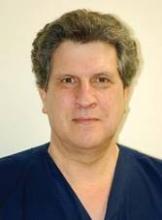SAN DIEGO – When performing dermatologic surgery, "fulfilling the expectations of patients and their families is the key to satisfaction," Dr. Howard K. Steinman said at a meeting sponsored by the American Society for Mohs Surgery.
"The yin and the yang of keeping patients satisfied involves fulfilling their expectations and satisfying their unmet expectations," Dr. Steinman said. "You have to do both. The trouble is, patient expectations are often unknown, vague, or inaccurate, or they’re irrational and unachievable. These types of expectations are dangerous and often the result of significant dissatisfaction, and unfortunately, litigation and complaints to medical boards."
Examples of nonspecific expectations include remarks such as "I want to look 10 years younger," "I hate my face," "I want to look like this picture," "what do you think I need, doctor?" and "my spouse wants me to have this fixed."
In these instances, expectations need to be modified before treatment, Dr. Steinman emphasized. This is all part of the consultation.
Dr. Steinman, who practices dermatology in Irving, Tex., shared techniques that help him to stay effective, centered, and calm while satisfying patient expectations.
To track these techniques, he advised using the mnemonic AIDET, which he learned during his post as director of dermatologic and skin surgery at Scott & White Clinic in Temple, Tex. AIDET stands for acknowledge, introduce, duration, explanation, and thank you.
The "acknowledge" component of AIDET involves a visible, audible, or tactile sign acknowledging the patient’s presence and an introduction. "Every person entering the exam room or operating room should introduce themselves to the patient," Dr. Steinman said. If loved ones accompany the patient, "I’ll introduce myself to them also, and ask how they’re related. I then go on to explain my role, my background and experience, and my intention to provide excellent service."
Next, provide an estimated time frame for how long the procedure will take. For example, during Mohs surgery cases, "I’ll take the specimen out, but before I leave the room I’ll say, ‘please have a seat in the waiting room. It’s going to be about 45 minutes until your slides are ready’ – even though this usually only takes 20-25 minutes. Overestimate the time so patients don’t become disappointed."
The "explanation" component of the mnemonic is crucial, Dr. Steinman said. He makes it a point to explain what he’s going to do during the procedure and asks the patient if he or she has any questions before he starts. "If the procedure is going to hurt, let the patient know," he said. "Offer to narrate what you’re doing if the patient finds that helpful. Keep the patient informed. Explain all tasks, sounds, smells, processes, and procedures, and have your staff do the same." For example, if the procedure involves cauterizing tissue, Dr. Steinman will tell the patient, "I’m going to start cauterizing. There is going to be a bad smell. You may want to breathe through your mouth."
Finally, thank patients "for the opportunity to care for them, for their time, their patience (if they had to wait), and for choosing you," he said.
Dr. Steinman said that he had no relevant financial conflicts to disclose.


